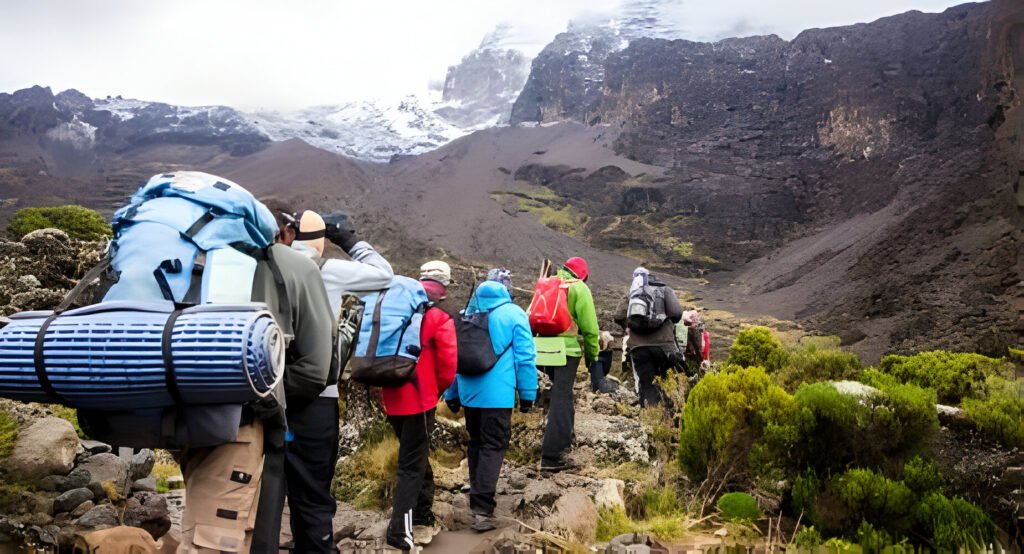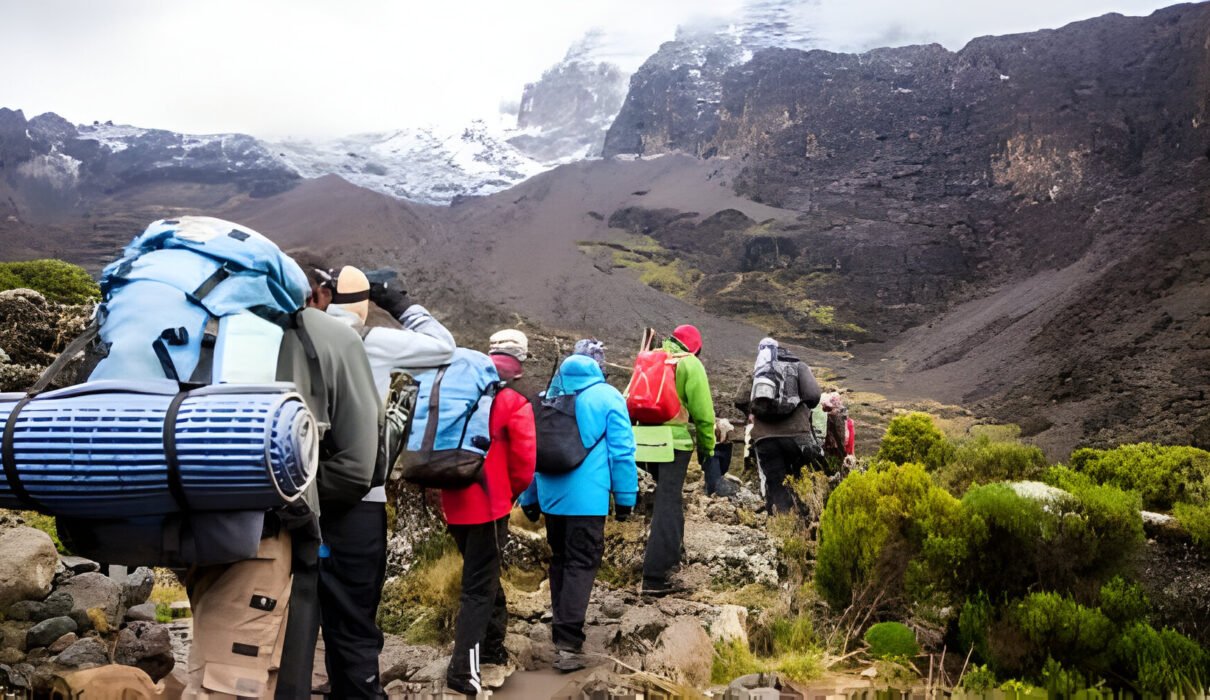The 9-days Northern Circuit Kilimanjaro Climb Unique Ascent is the most scenic, remote, and least crowded path to the summit of Mount Kilimanjaro, Africa’s highest peak. Known for its longer duration, this trek offers ample time for acclimatization, ensuring a higher success rate and a more enjoyable journey. This unique ascent takes you along the quieter northern side of the mountain, offering breathtaking views of both Kibo and Mawenzi peaks, as well as the Great Rift Valley.
In this guide, you’ll learn why the 9-days Northern Circuit Kilimanjaro Climb Unique Ascent is considered one of the best routes for experienced trekkers and beginners alike, and how to prepare for this unforgettable adventure.

Why Choose the 9-days Northern Circuit Kilimanjaro Climb Unique Ascent?
The Northern Circuit is the longest and one of the most scenic routes on Kilimanjaro. Here’s why it’s the perfect choice for your Kilimanjaro trek:
1. High Summit Success Rate, 9-days Northern Circuit Kilimanjaro Climb Unique Ascent
The 9-day Northern Circuit is the longest Kilimanjaro route, allowing for a slower, more gradual ascent. This extra time means better acclimatization, reducing the chances of altitude sickness and increasing your chances of successfully reaching the summit.
For more information on acclimatization and altitude sickness, visit Altitude.org’s guide.
2. Quiet and Remote Trek, 9-days Northern Circuit Kilimanjaro Climb Unique Ascent
One of the main reasons trekkers love the Northern Circuit is its remoteness. It’s the least crowded route on Kilimanjaro, giving you a more peaceful trekking experience. You’ll avoid the busier southern routes and enjoy the serenity of Kilimanjaro’s northern slopes.
Learn more about the benefits of quieter routes at Kilimanjaro Climb Specialist.
3. Diverse Landscapes and Wildlife, 9-days Northern Circuit Kilimanjaro Climb Unique Ascent
This route takes you through Kilimanjaro’s most diverse ecosystems. You’ll start in lush rainforests and pass through moorlands, alpine deserts, and volcanic rock formations before reaching the snow-capped summit. Along the way, you may spot wildlife such as buffaloes, colobus monkeys, and various bird species.
For more on Kilimanjaro’s unique landscapes, check out National Geographic’s Kilimanjaro page.
4. Spectacular Views of Kibo and Mawenzi, 9-days Northern Circuit Kilimanjaro Climb Unique Ascent
As you trek along the Northern Circuit, you’ll enjoy unparalleled views of Kibo and Mawenzi, Kilimanjaro’s two main peaks. The route offers sweeping vistas of both the Tanzanian plains and the neighboring Kenyan wilderness.

9-days Northern Circuit Kilimanjaro Climb Unique Ascent Itinerary
The 9-days Northern Circuit Kilimanjaro Climb Unique Ascent offers an extended journey with ample time for acclimatization and exploration. Here’s the day-by-day itinerary:
Day 1: Londorossi Gate to Mti Mkubwa Camp
- Elevation: 2,100 meters to 2,650 meters
- Hiking Time: 3-4 hours
- Distance: 7 km
Your adventure begins at Londorossi Gate, where you’ll complete park formalities before starting your trek. The hike leads you through the dense rainforest with chances to spot wildlife like colobus monkeys and blue monkeys. You’ll arrive at Mti Mkubwa Camp (Big Tree Camp) for your first overnight stay.
Learn more about Kilimanjaro’s wildlife at Eddy Tours & Safaris.
Day 2: Mti Mkubwa to Shira 1 Camp
- Elevation: 2,650 meters to 3,610 meters
- Hiking Time: 5-6 hours
- Distance: 8 km
Day two takes you out of the rainforest and onto the expansive Shira Plateau, a high-altitude desert that offers stunning views of Kilimanjaro’s peaks. You’ll camp at Shira 1 Camp, where you’ll enjoy panoramic views of the Great Rift Valley and Mount Meru.
Day 3: Shira 1 to Shira 2 Camp
- Elevation: 3,610 meters to 3,850 meters
- Hiking Time: 4-5 hours
- Distance: 7 km
On day three, you’ll continue across the Shira Plateau, enjoying breathtaking scenery as you trek to Shira 2 Camp. This is a shorter day, allowing you to rest and acclimatize at a higher elevation. You’ll also start to see the alpine desert landscapes that Kilimanjaro is known for.
Day 4: Shira 2 to Moir Hut
- Elevation: 3,850 meters to 4,200 meters
- Hiking Time: 5-7 hours
- Distance: 9 km
Day four is another acclimatization day, taking you from Shira 2 to Moir Hut, a remote camp at the base of the Lent Hills. You’ll have the option to take a short acclimatization hike to the nearby hills for better acclimatization.
For more on the importance of acclimatization, check out Healthline’s guide to high-altitude climbing.
Day 5: Moir Hut to Buffalo Camp
- Elevation: 4,200 meters to 4,020 meters
- Hiking Time: 5-7 hours
- Distance: 12 km
On day five, you’ll leave Moir Hut and begin trekking along the Northern Circuit itself. This part of the trail offers incredible views of the Kenyan wilderness to the north and Kilimanjaro’s glaciers. You’ll descend slightly to Buffalo Camp, which is situated in a remote part of the mountain, offering tranquility and seclusion.
Day 6: Buffalo Camp to Third Cave
- Elevation: 4,020 meters to 3,870 meters
- Hiking Time: 4-6 hours
- Distance: 8 km
Today’s trek takes you across the northern slopes of Kilimanjaro, offering fantastic views of Kibo Peak. You’ll arrive at Third Cave for the night, where you’ll rest before the summit push.
Day 7: Third Cave to School Hut
- Elevation: 3,870 meters to 4,800 meters
- Hiking Time: 4-5 hours
- Distance: 5 km
Day seven is a shorter but steeper hike to School Hut, the final camp before the summit. You’ll arrive in the early afternoon, giving you plenty of time to rest and prepare for the midnight summit attempt.
Day 8: School Hut to Uhuru Peak, Descend to Mweka Camp
- Elevation: 4,800 meters to 5,895 meters (summit), descend to 3,100 meters
- Hiking Time: 10-14 hours
- Distance: 19 km
Summit day begins just after midnight as you make your final push to Uhuru Peak, the highest point in Africa. After reaching the summit and celebrating your achievement, you’ll begin your descent to Mweka Camp, where you’ll spend your last night on the mountain.
For tips on how to prepare for summit day, check out Kilimanjaro Climb Specialist’s summit guide.
Day 9: Mweka Camp to Mweka Gate
- Elevation: 3,100 meters to 1,640 meters
- Hiking Time: 3-4 hours
- Distance: 10 km
On your final day, you’ll descend through the lush rainforest to Mweka Gate, where you’ll receive your summit certificate and say goodbye to your guides and porters.
What’s Included in the 9-days Northern Circuit Kilimanjaro Climb Unique Ascent ?
This all-inclusive package covers everything you need for a successful and comfortable Kilimanjaro trek:
1. Professional Guides and Porters
Your climb will be led by experienced guides who are experts in Kilimanjaro’s unique terrain and weather conditions. Porters will carry your gear, ensuring you can focus on the climb without the added weight.
For more about the importance of expert guides, visit Eddy Tours & Safaris.
2. High-Quality Camping Equipment, 9-days Northern Circuit Kilimanjaro Climb Unique Ascent
You’ll stay in four-season mountain tents, designed to withstand Kilimanjaro’s harsh weather. All camping equipment, including sleeping mats and tents, is provided.
3. Meals and Drinking Water, 9-days Northern Circuit Kilimanjaro Climb Unique Ascent
Freshly prepared meals will be provided throughout the trek, ensuring you stay nourished and energized. Safe drinking water will also be available at each camp.
4. Kilimanjaro National Park Fees, 9-days Northern Circuit Kilimanjaro Climb Unique Ascent
All necessary park fees, camping fees, and rescue fees are included in the package, ensuring you have full access to Kilimanjaro National Park.
For more on park regulations, visit Tanzania National Parks Authority (TANAPA).
5. Safety Gear and First Aid, 9-days Northern Circuit Kilimanjaro Climb Unique Ascent
Your safety is our top priority. The package includes oxygen tanks, first-aid kits, and pulse oximeters to monitor your health at high altitudes.
How to Prepare for Your 9-days Northern Circuit Kilimanjaro Climb Unique Ascent
1. Training for Kilimanjaro, 9-days Northern Circuit Kilimanjaro Climb Unique Ascent
The Northern Circuit is one of the longer routes on Kilimanjaro, so it’s important to start training several months in advance. Focus on cardio exercises, strength training, and hiking with a weighted backpack to build endurance.
For a detailed training guide, visit Outside Online’s Kilimanjaro training guide.
2. Packing Essentials, 9-days Northern Circuit Kilimanjaro Climb Unique Ascent
Packing the right gear is crucial for a successful trek. Here’s a quick packing list:
- Warm clothing layers: Include thermal layers, fleece jackets, and a down jacket.
- Sturdy hiking boots: Ensure they are well broken-in to avoid blisters.
- Waterproof gear: A good rain jacket and waterproof pants are essential.
- Trekking poles: These help with balance and reduce stress on your knees.
For a full packing list, visit Ultimate Kilimanjaro’s packing guide.
Frequently Asked Questions (FAQs), 9-days Northern Circuit Kilimanjaro Climb Unique Ascent
1. Is the Northern Circuit suitable for beginners?
Yes, the Northern Circuit is suitable for beginners due to its slow, gradual ascent, which allows for better acclimatization. The longer duration increases the chances of a successful summit.
2. What is the success rate of the Northern Circuit?
The Northern Circuit has one of the highest success rates of all Kilimanjaro routes, thanks to the extra time for acclimatization.
For more on success rates, visit Kilimanjaro Climb Specialist.
3. When is the best time to climb Kilimanjaro via the Northern Circuit? 9-days Northern Circuit Kilimanjaro Climb Unique Ascent
The best time to climb Kilimanjaro is during the dry seasons, from January to March and June to October. These months offer more stable weather conditions and clearer skies.
For more on the best time to climb Kilimanjaro, visit BBC Weather’s Kilimanjaro guide.
4. What kind of wildlife can I expect to see on the Northern Circuit?
The Northern Circuit offers chances to see wildlife, especially in the lower altitudes, including colobus monkeys, buffaloes, and various bird species.
5. What kind of accommodations are provided on the Northern Circuit? 9-days Northern Circuit Kilimanjaro Climb Unique Ascent
9-days Northern Circuit Kilimanjaro Climb Unique AscentYou’ll stay in four-season mountain tents at designated camps along the route. These tents are designed to keep you comfortable and safe throughout the climb.
For more information or to book your 9-Day Northern Circuit Kilimanjaro Climb, visit Kilimanjaro Climb Specialist and Eddy Tours & Safaris.

